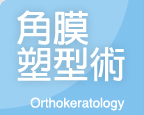
配戴夜戴型角膜塑形鏡片後角膜前後弧度的變化---初步結果
Changes of anterior and posterior corneal curvature after wearing
overnight orthokeratology lenses --- preliminary results
配戴夜戴型角膜塑形鏡片後角膜前後弧度的變化---初步結果
丘子宏* 鄭惠川+ 丘子雲*
丘子宏眼科診所* 馬偕紀念醫院眼科+
Orthokeratology has been used for long time as one of the corrective methods for myopic patients. It is getting popularity for overnight wear, with the results of better vision during the daytime and the possible effect in control the myopia progression. However, the exact mechanism of orthokeratology remained uncertain. Most researchers agree corneal epithelium redistribution may be the most possible mechanism but the role of corneal bending is not completely excluded. The purpose of present study is to investigate the change of posterior corneal curvature induced by overnight wearing of orthokeratology lens by using the Scheimpflug imaging corneal analyzer.
Materials and methods:
Sixty four eyes of 32 children were enrolled in the present study. All patients received detail ophthalmic examinations including auto-refraction, manifested and cycloplegic refraction, slit-lamp bio-microscope for anterior segment, tear film and fundus examination. Pentacam examination was also performed. Orthokeratology lenses were fitted and instructed to use during sleeping. Patients were seen regularly and Pentacam examination was repeated after wearing the lenses for 3 months. It was performed after removing the lenses for at least 2 hours.
Results:
The average age of 32 children was 11.7 y/o (9-16). The mean spherical equivalent refraction of 64 eyes was -3.70±1.67D. The flat K of anterior corneal surface measured by autorefracter was 42.92±1.34D before wearing OK lens and flattened to 40.76±1.19D three months later. The difference was statistically significant (p<0.001). The mean K of anterior and posterior cornea taken by Pentacam was 43.51±1.31D and -6.29±0.22D before OK lens wearing and 42.03±1.17D and -6.29±0.21D after 3 months respectively. The change of anterior mean K before and after OK lens was highly significant (p<0.001), but that of posterior mean K was not (p=0.859) (Table). The change of central corneal thickness was also significant, from 553.94±31.23µm before to 543.31±31.47µm after 3 months(p<0.001).
Table
Change of anterior and posterior cornea curvature before and after wearing OK lens
|
Before OK lens 3 months visit p
|
Auto flat K (D) 42.92±1.34 40.76±1.19 <0.001
Pentacam mean K (D)
Anterior 43.51±1.31 42.02±1.17 <0.001
Posterior -6.29±0.22 -6.29±0.21 =0.859
|
|
|
Discussion:
Orthokeratology has been used to temporarily reduce myopia for decades by reshaping the corneal apex with reverse-geometry rigid contact lens (OK lens). The corneal reshaping includes flattening of apex and steepening of mid-peripheral of the cornea and was believed resulted from redistribution of corneal epithelium1-2. However some researcher observed flattening of the posterior surface in the early adaptive stage of OK lens wear3. With the use of new diagnostic instruments like Pentacam, a Scheimpflug image corneal analyzer, most authors found that OK lens wearing can cause flattening of anterior corneal curvature but did not cause significant change of the posterior curvature4-6. Our study confirms the results of flattening of anterior curvature with no change of posterior surface in overnight wearing of OK lens for 3 months. These findings indicate the effect of orthokeratology mainly comes from the anterior surface of the cornea but not from the change of stroma and posterior surface. But the exact cause of anterior corneal flattening is still not fully understood. The study of the primate corneas by Cheah indicates the central corneal thinning was both stromal and epithelial in origin. He also found significant epithelial cell shape alteration with short-term OK lens wear7 . This finding suggests that the corneal epithelium is moldable in response to the physical forces generated by the OK lens, so that epithelial redistribution may not be the sole mechanism of corneal flattening. Although the present study and other researches confirm that posterior corneal curvature is not affected by orthokeratology, there is very limited study about the influence of orthokeratology on corneal stroma . |
Conclusion:
Overnight wearing of orthokeratology lens for three months in children will flatten the anterior corneal curvature and decrease the central corneal thickness. The posterior corneal curvature remains unchanged. These findings explain that effect of orthokeratology is mainly from the change of corneal epithelium. However, the influence of orthokeratology lens on the corneal stroma needs further investigation.
References
1.Swarbick HA, Wong G, O’Leary DJ. Corneal response to orthokeratology. Optom Vis Sci. 1998;75:791-9.
2.Sridharan R, Swarbrick H. Corneal response to short-term orthokeratology lens wear. Optom Vis Sci. 2003;80:200-6.
3.Owens H, Garner LF, Craig JP, Gamble G. Posterior corneal change with orthokeratology. Optom Vis Sci. 2004;81:421-6.
4.Stillitano IG, Chalita MR,Schor P, Maidana E, Lui MM, Lipener C, Hofling-Lima AL. Corneal changes and wavefront analysis after orthokeratology fitting test. Am J Ophthalmol. 2007; 144:378-86.
5.Tsukiyama J, Miyamoto Y, Higaki S, Fukuda M, Shimomura Y. Changes in the anterior and posterior radii of the corneal curvature and anterior chamber depth by orthokeratology. Eye Contact Lens .2008;34:17-20.
6.Chan D, Lam AK, Cho P. Posterior corneal curvature change and recovery after 6 months of overnight orthokeratology treatment. Ophthalmic and Physiological Optics. 2010; 30:274-280.
7.Cheah PS, Norhani M, Bariah MA, Myint M, Lye MS, Azian AL. Histomorphometric profile of the corneal response to short-term reverse-geometry orthokeratology lens wear I primate corneas: a pilot study. Cornea. 2008:27:461-70.











